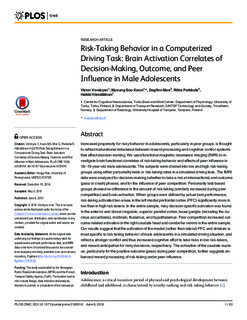| dc.contributor.author | Vorobyev, Victor | |
| dc.contributor.author | Kwon, Myoung Soo | |
| dc.contributor.author | Moe, Dagfinn | |
| dc.contributor.author | Parkkola, Riitta | |
| dc.contributor.author | Hämäläinen, Heikki | |
| dc.date.accessioned | 2019-02-04T11:30:29Z | |
| dc.date.available | 2019-02-04T11:30:29Z | |
| dc.date.created | 2015-08-31T11:43:29Z | |
| dc.date.issued | 2015 | |
| dc.identifier.issn | 1932-6203 | |
| dc.identifier.uri | http://hdl.handle.net/11250/2583718 | |
| dc.description.abstract | Increased propensity for risky behavior in adolescents, particularly in peer groups, is thought to reflect maturational imbalance between reward processing and cognitive control systems that affect decision-making. We used functional magnetic resonance imaging (fMRI) to investigate brain functional correlates of risk-taking behavior and effects of peer influence in 18–19-year-old male adolescents. The subjects were divided into low and high risk-taking groups using either personality tests or risk-taking rates in a simulated driving task. The fMRI data were analyzed for decision-making (whether to take a risk at intersections) and outcome (pass or crash) phases, and for the influence of peer competition. Personality test-based groups showed no difference in the amount of risk-taking (similarly increased during peer competition) and brain activation. When groups were defined by actual task performance, risk-taking activated two areas in the left medial prefrontal cortex (PFC) significantly more in low than in high risk-takers. In the entire sample, risky decision-specific activation was found in the anterior and dorsal cingulate, superior parietal cortex, basal ganglia (including the nucleus accumbens), midbrain, thalamus, and hypothalamus. Peer competition increased outcome-related activation in the right caudate head and cerebellar vermis in the entire sample. Our results suggest that the activation of the medial (rather than lateral) PFC and striatum is most specific to risk-taking behavior of male adolescents in a simulated driving situation, and reflect a stronger conflict and thus increased cognitive effort to take risks in low risk-takers, and reward anticipation for risky decisions, respectively. The activation of the caudate nucleus, particularly for the positive outcome (pass) during peer competition, further suggests enhanced reward processing of risk-taking under peer influence. | nb_NO |
| dc.description.abstract | Risk-taking behavior in a computerized driving task: Brain activation correlates of decision-making, outcome, and peer influence in male adolescents | nb_NO |
| dc.language.iso | eng | nb_NO |
| dc.publisher | Plos One | nb_NO |
| dc.rights | CC BY 4.0 | * |
| dc.rights.uri | http://creativecommons.org/licenses/by-nc-nd/4.0/deed.no | * |
| dc.title | Risk-taking behavior in a computerized driving task: Brain activation correlates of decision-making, outcome, and peer influence in male adolescents | nb_NO |
| dc.type | Journal article | nb_NO |
| dc.type | Peer reviewed | nb_NO |
| dc.description.version | publishedVersion | nb_NO |
| dc.rights.holder | © 2015 Vorobyev et al. | nb_NO |
| dc.subject.nsi | VDP::Samfunnsvitenskap: 200 | nb_NO |
| dc.source.volume | 10 | nb_NO |
| dc.source.journal | PLoS ONE | nb_NO |
| dc.source.issue | 6 | nb_NO |
| dc.identifier.doi | 10.1371/journal.pone.0129516 | |
| dc.identifier.cristin | 1260848 | |
| cristin.unitcode | 7401,30,70,0 | |
| cristin.unitname | Mobilitet og samfunnsøkonomi | |
| cristin.ispublished | true | |
| cristin.fulltext | original | |
| cristin.qualitycode | 1 | |

